One of the biggest questions I get about preparing for Kilimanjaro is how much preparation and training it takes. The answer is, probably less than you think. At least if you have a good baseline fitness.
If you aren’t much of a hiker, and you don’t spend much time working out otherwise, you might need to consider training for longer. That doesn’t necessarily mean training harder, though. You mainly want to take the additional time to build up strength and stamina if you’re starting from a lower fitness level.
Another question I see online a lot is what to pack for Kilimanjaro. This question was a major one I had myself, and I mildly stressed over leading up to the trek. The answer again here is probably less than you think.
In this post, I’ll help answer those two questions. At the bottom, I share mine and my partners’ packing lists, including things we rented.
Preparing for Kilimanjaro: Training
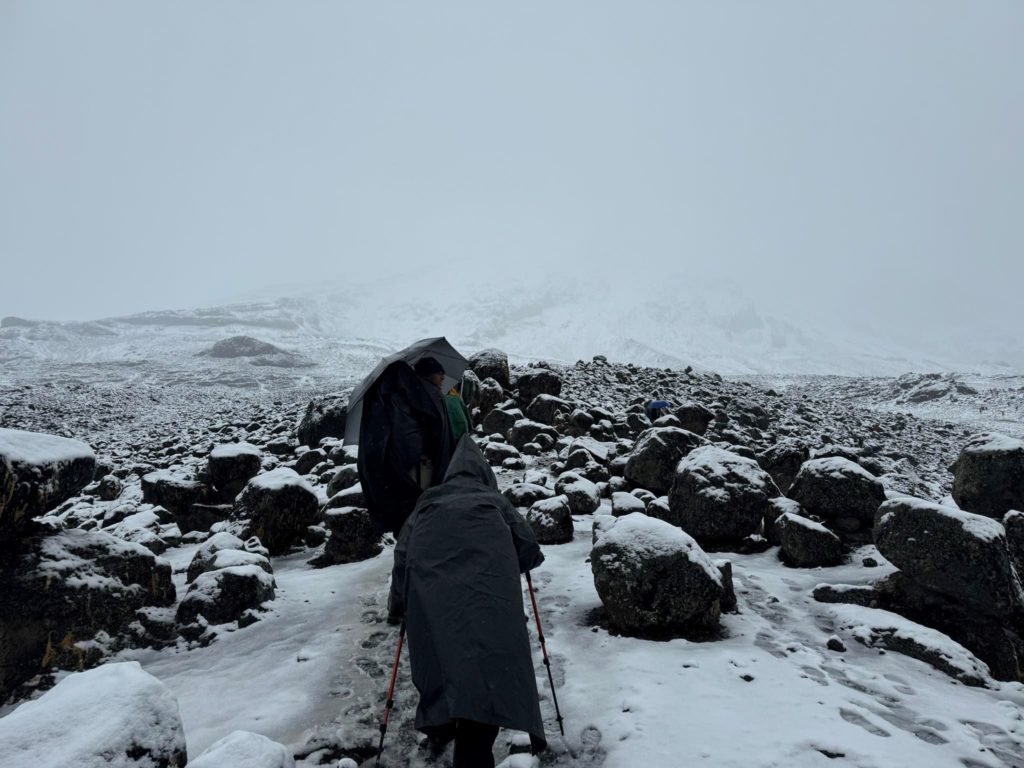
Kilimanjaro is the highest point in all of Africa and the tallest freestanding mountain in the world. Those stats make it sound intimidating, and sometimes people assume it requires a strict and rigorous training regimen.
In fact, Kilimanjaro is one of the more accessible of the famous “Seven Summits” – the mountains that make up the tallest point on each continent. Reaching the summit is even more accessible than some smaller summits around the world.
The reason for this is because climbing Kilimanjaro really doesn’t require any technical skills. If you’re taking a route that passes the Barranco Wall, you will need to be prepared for a little bit of scrambling. But other than that, it really is a matter of being in good enough shape to climb up and down a mountain for miles every day, multiple days in a row.
With that being said, I don’t think preparing for Kilimanjaro should be taken lightly. A lot of people say that the only hard thing about Kilimanjaro is the altitude, but I would disagree. It does take strength, stamina and effort to be able to hike at elevation for about 3-8 miles per day for 6-8 days in a row (on average).
Prior to Kilimanjaro, I’d gone on hikes where I’d covered up to 17 miles in one day, but I’d always been able to rest my aching body the next day. Even on “rest days” on Kilimanjaro, you’re still hiking around three miles.
With that said, there are three main areas I recommend focusing on when preparing for Kilimanjaro:
- Cardio strength
- Lower body strength
- Mental strength
Note that I’m not any sort of trained professional on this matter – these are only my opinions based on my experiences with preparing for Kililmanjaro and years of fitness.
Preparing for Kilimanjaro: Cardio Strength
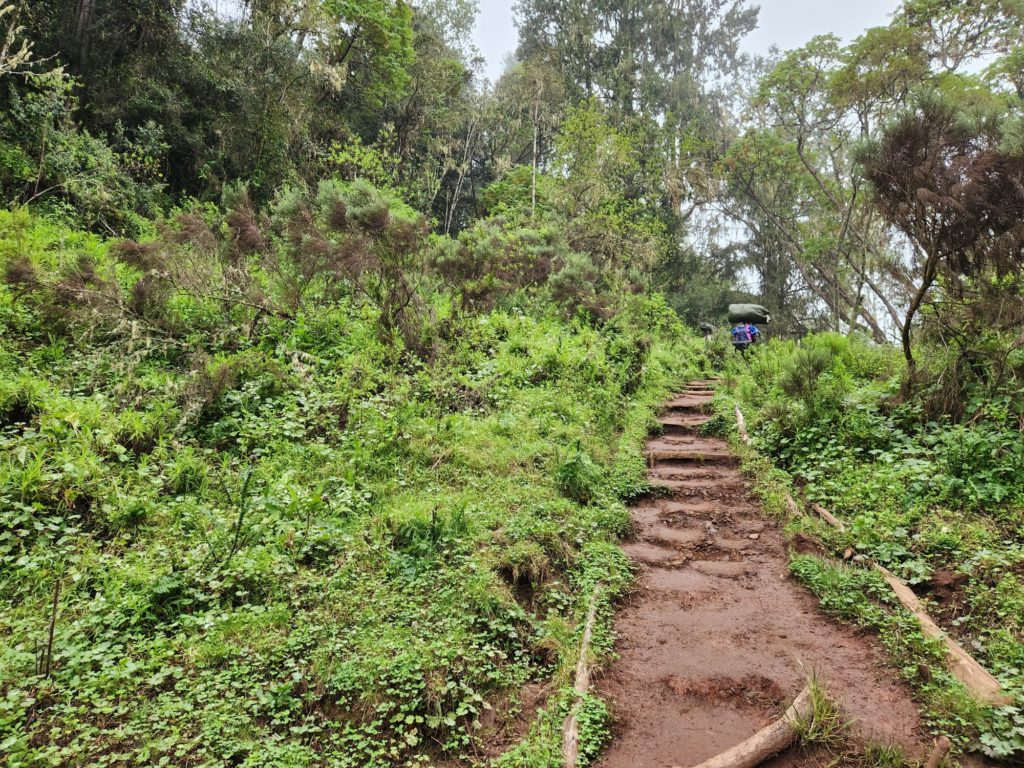
Cardio training is incredibly important for climbing Kilimanjaro, especially if you’re used to being at sea level. Cardiovascular health helps strengthen your heart, lungs and overall stamina. When trekking for multiple days in a row, it’s important to have solid cardio strength.
If you already have a good fitness baseline, I recommend increasing your cardio regimen about 4-6 weeks before your trek at least 3x per week. If you need more work on your cardio strength, I recommend starting at least 12 weeks prior to your trek.
Some ways to work on cardio:
- Training hikes
- Running
- High-intensity interval training (HIIT)
- Biking
- Swimming
- Elliptical
On top of this higher intensity cardio training, I recommend walking at least 4-6 cumulative miles per day. If you aren’t used to walking that much on a daily basis on top of additional cardio, start with lower mileage and increase over weeks.
Preparing for Kilimanjaro: Lower Body Strength
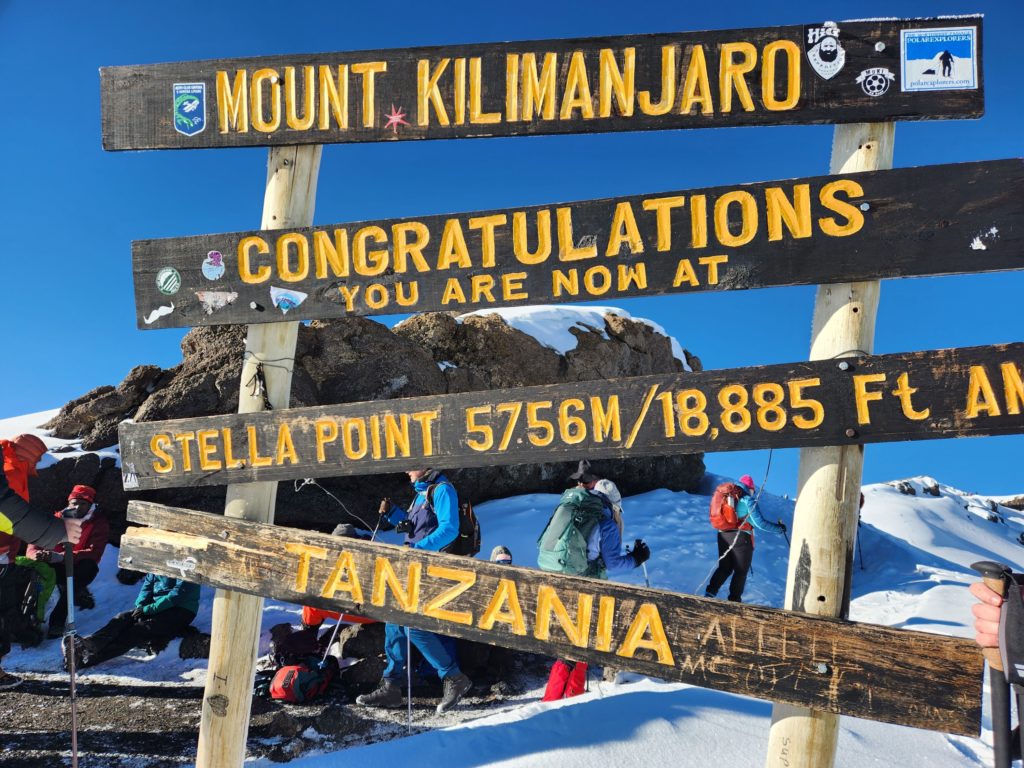
It’s probably self-explanatory, but you definitely need to make sure you have strong lower body muscles before climbing a nearly 20,000-foot mountain. Although I have decent lower body strength in general, I found myself having glute pain and fatigue for probably the first time ever while hiking on summit day.
I recommend strengthening glutes, hamstrings, quads and calves before your climb, probably about 2x per week. Some strengthening exercises I recommend include:
- Training hikes that gain >1,000 feet in elevation
- Stair climber machine
- Climbing/running stairs/stadiums
- Box jumps
- Squats
- Lunges
- Deadlifts
- Weighted Good Mornings
- Calf raises
- Donkey kicks
Although lower body strength is most important, you also need decent upper body strength. You need to be able to carry a daypack filled with layers and daily essentials on your trek every day, which requires good back strength. If you’re climbing a route with the Barranco Wall, you’ll also need some full body strength when scrambling. Make sure to incorporate some upper body and core training into your exercises like push-ups, pull-ups, bicep curls, lat pull-downs and sit-ups.
You don’t need to over-index on upper body and core strength when training, but don’t completely neglect it either.
Preparing for Kilimanjaro: Mental Strength
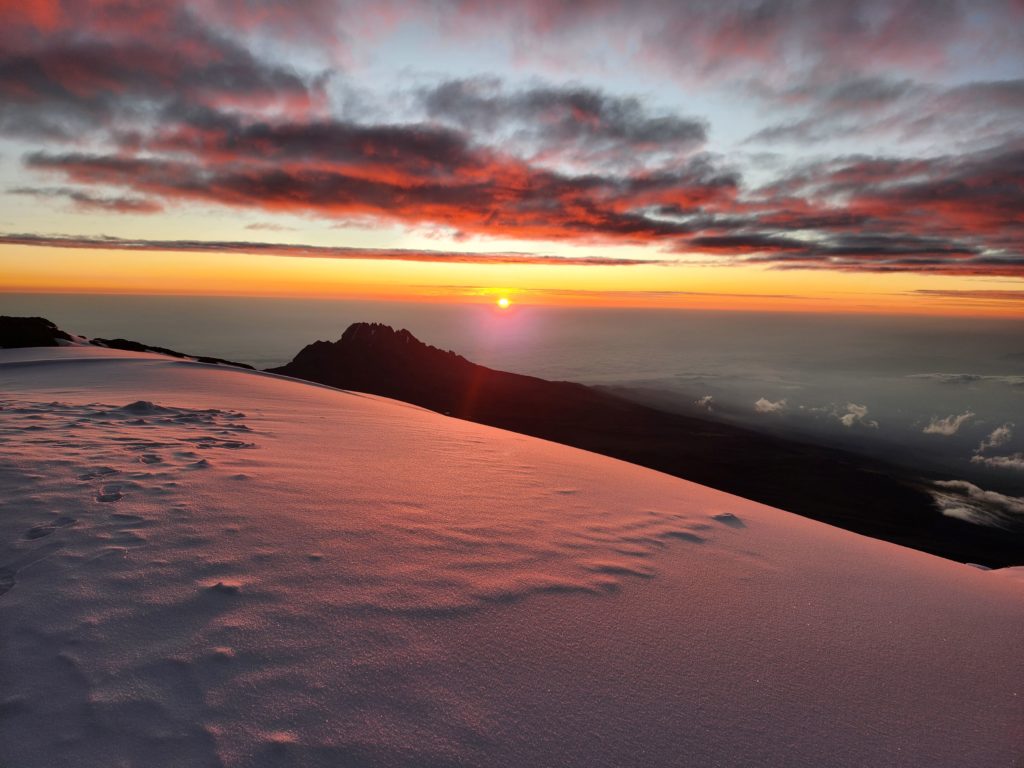
I knew summiting Kilimanjaro would be a major physical challenge, but I didn’t realize it would also be such a tough mental challenge. There were multiple moments on the trail when I worried about my ability to make it, and not because I was physically incapable.
Not everyone will get frustrated or down on the trail like I did. But if you do, I want you to know that you’re not alone. If you have mindfulness practices like yoga and meditation, I recommend continuing a regular practice leading up to your trek. If you’re a sensitive person usually, I also recommend keeping a journal to help you express your feelings.
Above all, I recommend accepting that you might have one or many ‘moments’ during your trek where you are feeling a lot of emotions – especially at altitude. Think about your best ways to deal with emotional moments and ensure you have a good outlet when on the trail.
My Training Regimen to Prepare for Kilimanjaro
To prepare for Kilimanjaro, I used the same weighted HIIT routine I did when preparing to climb the Inca Trail to Machu Picchu. I also ran and used the elliptical for cardio, as well as did some training hikes. I started this routine about 6 weeks before the trek.
- Weighted HIIT workout 2-3x per week
- Elliptical 2x per week
- Run 1x per week
- Yoga 1x per week
- Daily walks
- Supplemented with mild training hikes/walks with loaded daypack
Because it was winter, there was no easy access for more difficult hikes at higher elevation right before the trek. I did some hiking during my trip in Ireland about 1.5 months prior, but mostly relied on past hiking experience.
One thing I wish I’d done was spend 1-2x per week working more specifically on strengthening my lower body. The weighted HIIT workouts were total body strengthening exercises, but I could have benefitted from more solely leg days. (Who couldn’t?)
Packing for Kilimanjaro: Clothing and Equipment
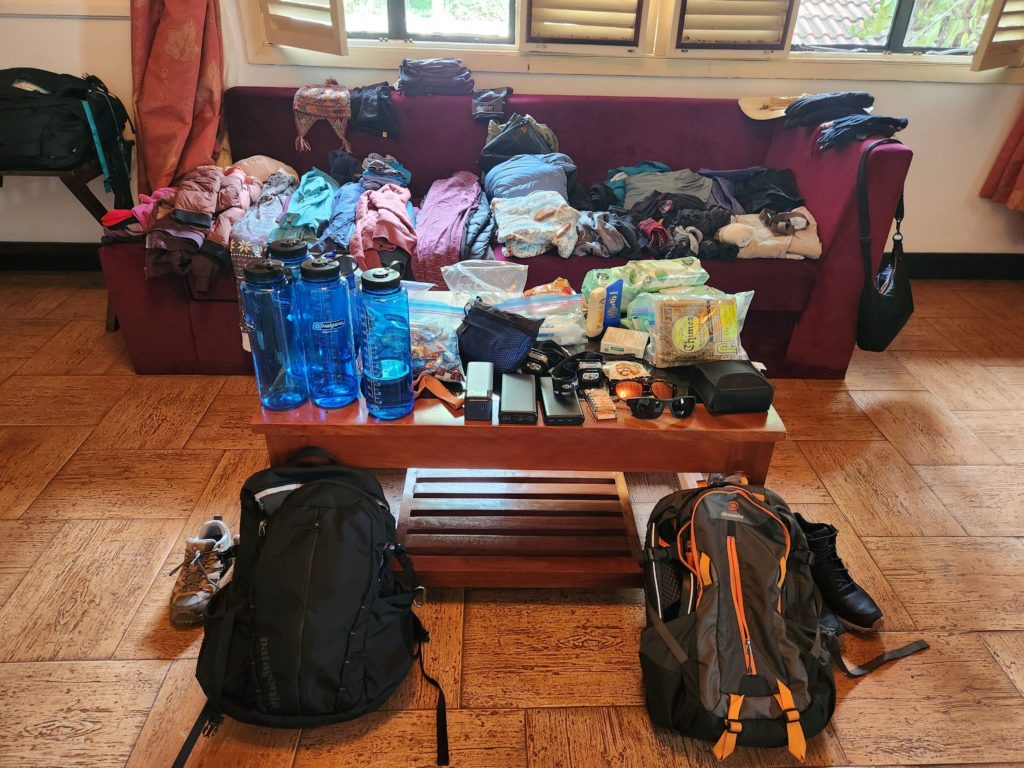
There are two clothing-related rules on Kilimanjaro: Stay warm, and stay dry. I was concerned about both of these when creating my packing list, especially the former.
Below is what I’d recommend bringing with you on a Kilimanjaro trek and why. I’ve linked some of the things I bought that I thought were especially durable and helpful, or brands I wished I’d considered instead of what I brought.
Note that some of these are affiliate links. If you use them, I may get a small commission at no additional cost to you.
Lower Body Clothing:
- Hiking/exercise pants: I brought exercise pants because I like their stretchiness and flexibility, and I like how I can easily layer them under warmer pants.
- Lined leggings or sweatpants: I recommend packing 1-2 pairs of lined leggings or sweatpants to layer with on summit day and potentially sleep in on cooler nights.
- Down pants: My down pants were so helpful in keeping me warm both on summit day, and during the cooler nights at camp. I even slept in them some nights.
- Hiking/exercise shorts: I recommend one pair of shorts for the last day. The humidity as you descend into Moshi is intense because you’ve just spent several days in cool mountain weather.
Upper Body Clothing:
- Hiking/exercise shirts: I mainly brought exercise shirts, which I appreciated again for their flexibility, and because they tend to have built-in sports bras.
- Long-sleeved shirts: Bring a few pairs of long-sleeved shirts to layer on top of exercise or hiking shirts.
- Fleece: I recommend at least one fleece to layer up on cooler days and nights. I also used mine at the cooler camps and sometimes to sleep.
- Down jacket: I used a lightweight down jacket with a solid fill number. It kept me warm both on summit night and at camp. Because I was worried about it being too lightweight, I rented a larger down jacket from my trekking company, but it turned out to be unnecessary.
- Outer shell jacket: This clothing is a good mid layer to help you stay warm and keep you safe from the elements.
Rain Gear:
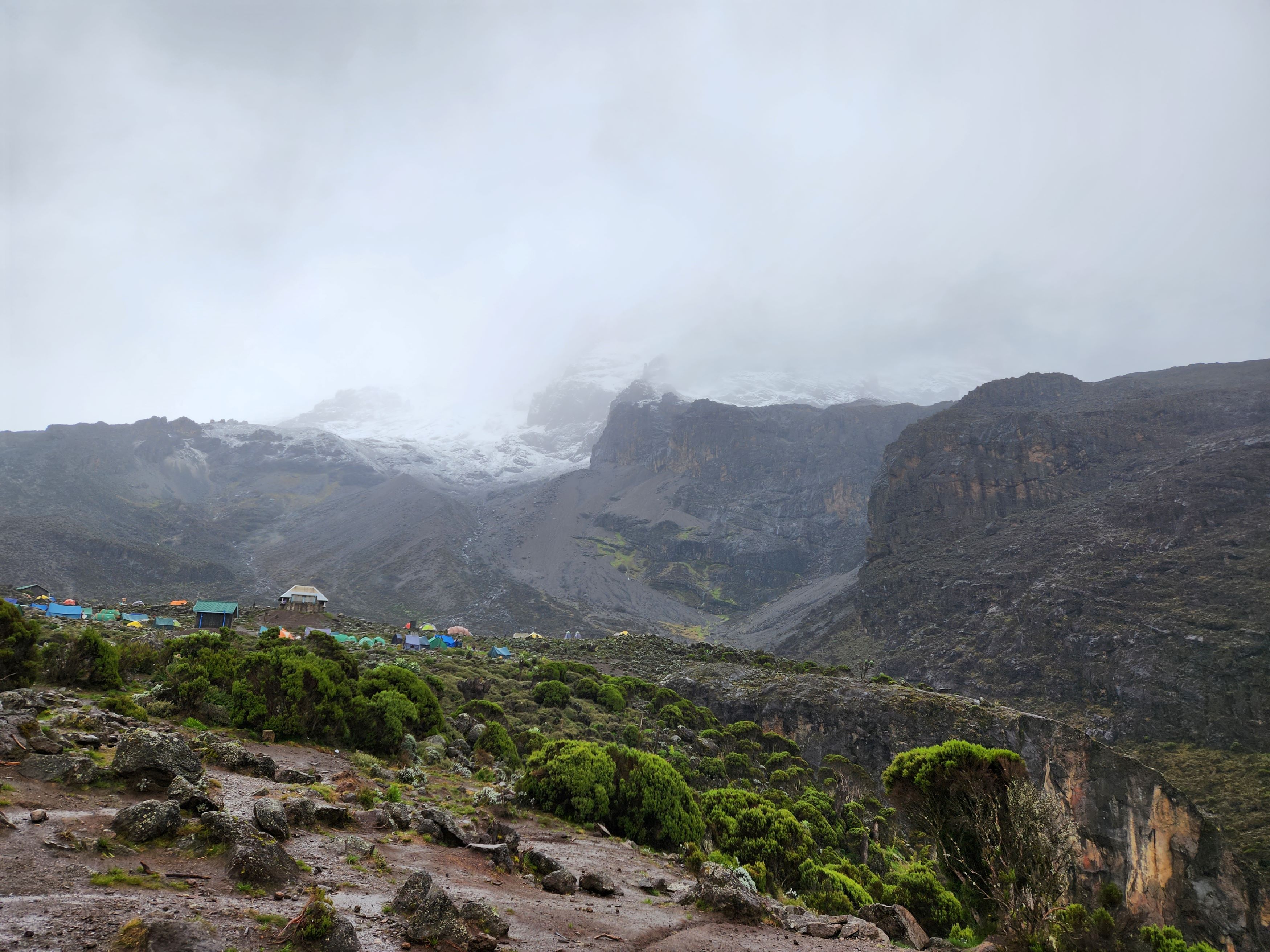
- Rain jacket: Make sure to get a high-quality rain jacket that will really repel the rain and keep you warm. I got this jacket from REI that was great at keeping me dry, and was easily packable as it rolled up into its own left pocket.
- Poncho [link]: Because staying dry is so important, you do need both a poncho and a rain jacket. I really like these ponchos from Amazon because they’re great at keeping you dry and dry quickly. Plus, they’re surprisingly durable. We used ours nearly every day, and they never tore at all. They were in such good shape at the end of the trek that we donated them to porters from our trekking company.
- Rain pants: I rented these from the trekking company, and I’m really glad I did. I initially didn’t think I’d need them because I had the poncho, and my exercise pants are quick drying. It rained so often that I was glad I had them to keep me dry.
- Leg gaiters: I also rented these from the trekking company because I didn’t realize how important they would be for staying clean and dry in the rain and mud. I’m really glad I rented them rather than buying them because they were incredibly muddy at the end of the trek, and I was glad I didn’t have to pack them.
- Backpack rain cover: Not clothing technically, but very important for keeping your backpack dry in the rain. I also rented this just because I forgot about getting one beforehand.
Miscellaneous Clothing:
- Wool socks [link]: This material is good for socks because they keep your feet warm and are quick drying.
- Beanie or other warm hat: This is helpful for keeping your head and ears warm. I wasn’t able to use mine on days I was sensitive to headaches.
- Ear warmers [link]: I recommend bringing something like these Columbia ear warmers, especially if you’re prone to headaches like me. This piece of fabric was incredibly helpful in keeping me warm when I couldn’t wear a hat.
- Sun hat: It’s not all rain! There are plenty of sunny days on Kilimanjaro, and a sun hat provides necessary protection.
- Long johns [link]: I recommend one pair for sleeping, and one pair to act as a base layer on summit night.
- Underwear: Self-explanatory (I hope).
If you bring any clothes you no longer need or don’t want at the end of the trek, you can donate them to porters from your trekking company.
Equipment:
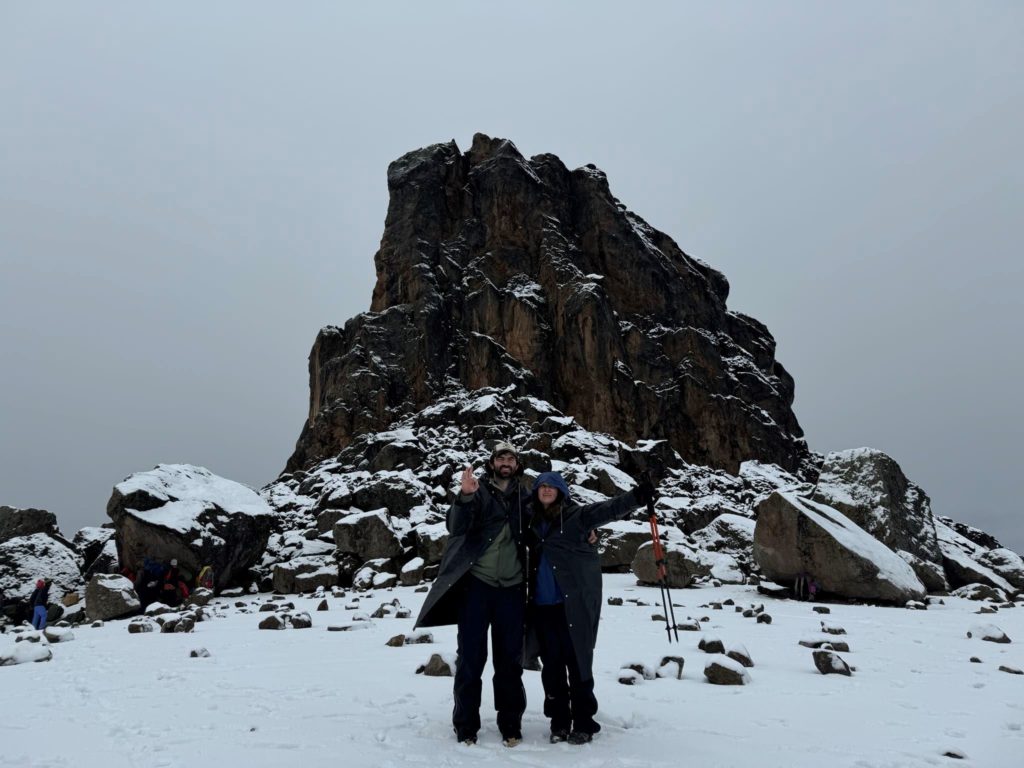
Must have:
- Worn in hiking shoes: High-quality, water-resistant hiking shoes or boots are critical to your climb. Make sure you’ve properly broken in your shoes and are not trying to trek in a brand new pair.
- 25-30L Daypack: I used a 28L Patagonia backpack I already had, but it honestly probably wasn’t the best idea for this trek. If I were to redo it, I’d probably have used a daypack like this one from Osprey. I use Osprey as my travel backpacks and have a smaller Osprey daypack I take on day hikes, and I really like how their backpacks fit my back.
- Trekking poles: I chose to rent these from the trekking company so I didn’t have to check anything on the flight. Even if you’re a strong hiker, I recommend bringing trekking poles at least for summit day.
- Four seasons sleeping bag: I also chose to rent my sleeping bag from the trekking company rather than purchase a new four seasons bag. It also gave me less to carry.
- Sleeping bag liner: A liner is good for keeping you warm, especially if you’re renting the bag.
- Liner gloves and ski gloves: Make sure you bring these to keep your hands warm. I only needed the liner gloves, but my partner used ski gloves at the summit.
- Water bottles or bladder [link]: You should aim to drink at least 3L of water every day, so you should bring this equivalent in bottles or bladder. We chose to bring bottles due to concern over the bladder freezing at camp or on summit night.
- Sunscreen: Make sure to bring this for protection from the sun.
- Headlamps: You’ll need a headlamp with fresh batteries at camp at night, and for the first six hours of summit night.
Recommended:
- Hot hands [link]: I highly recommend bringing some hand warmers like Hot Hands to stay warm on cooler nights. A lot of people bring these in their pockets or gloves on summit night. However, I used them in my sleeping bag in the last few camps to stay warm at night.
- Knee brace [link]: If you have any issues with your knees whatsoever or have any reason to be concerned about them, I highly recommend bringing a knee brace particularly for summit night when you’ll spend hours climbing down a steep mountain trail.
- Crampons: I rented these as well, just in case they were needed for snow and ice. I used them on Summit night.
- Exercise watch [link]: If you want to track things like steps, heart rate, sleep quality, etc., an exercise watch like a Fitbit can be nice to have.
- Cards/journal/book/Kindle: There is plenty of downtime at camp, so bring some things like this to help pass the time.
- Baby wipes: You won’t be showering, so make sure to bring plenty of baby wipes to stay clean.
- Portable battery: Bring at least one, but consider two, to ensure you can charge all your electronics.
- Menstrual products: If you’re someone who gets their period, I recommend bringing supplies. Even if it’s not your time of the month, altitude can do weird things to your body.
Packing for Kilimanjaro: Medication & Nutrition
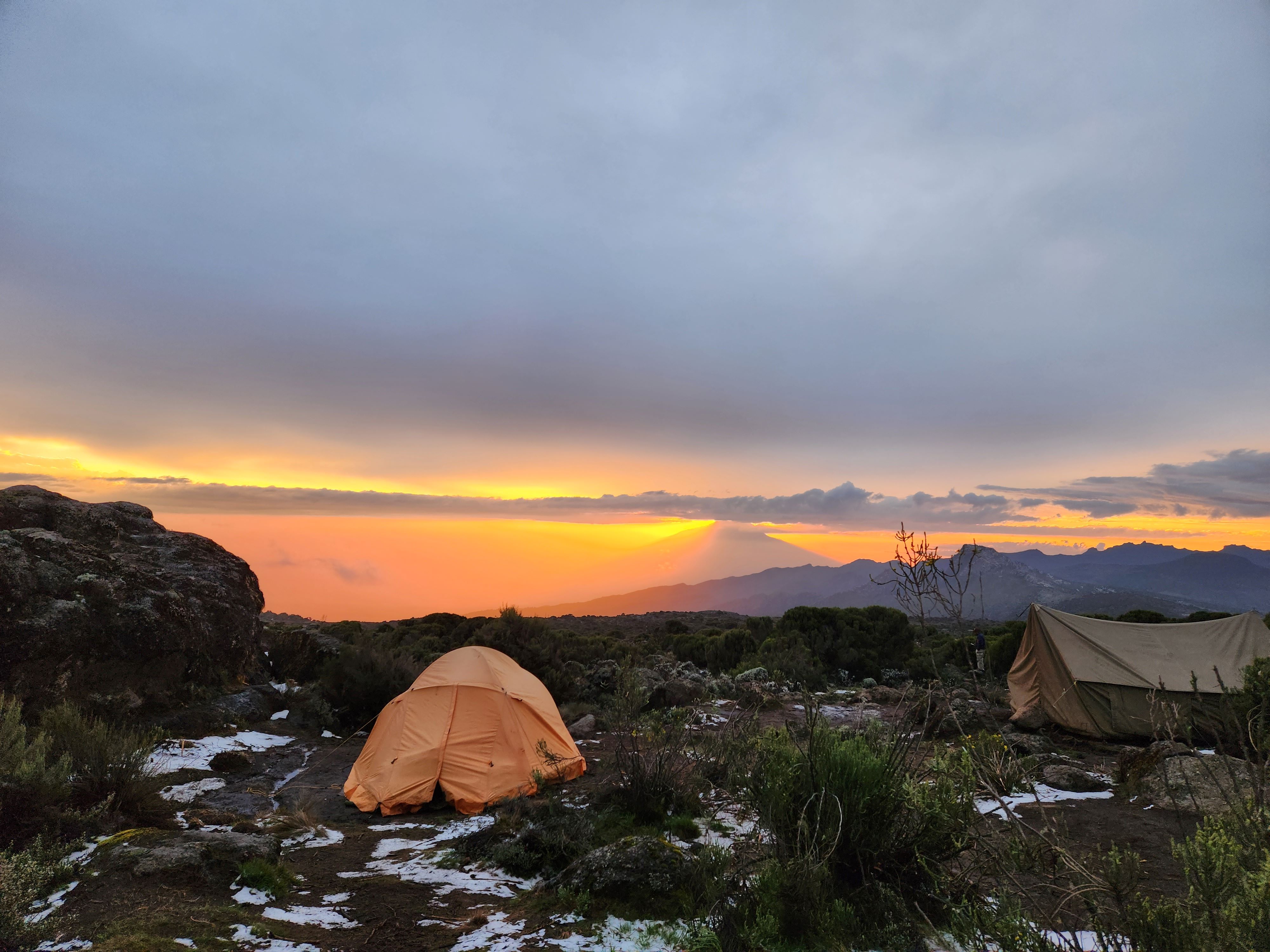
While your trekking company should look after your health and nutrition and provide you with meals and some snacks, you should still bring some medication and snacks to look after your health. Snacks you know you enjoy can be especially helpful at altitude when you don’t really have an appetite but need to eat.
Medication:
- Altitude sickness medication (Diamox): I was unsure if I’d take altitude sickness medication leading up to the trek, but I was glad I ultimately decided to do so. Because I wanted to give myself every advantage possible to increase my chances of successfully summiting, I ultimately decided to take it.
- Ibuprofen: Without Ibuprofen, it would have been hard to get over the headaches I had on the first four days of the trek.
- Antibiotic for stomach issues: While neither of us ended up needing this antibiotic, it was good to have for peace of mind in case we ended up picking up a stomach bug.
- Emergen-C: We brought this supplement both for additional vitamin C to help boost our immune systems and for the electrolytes.
- Malaria medication (malarone): I did not take any malaria medication before or during the trek because risk of malaria was relatively low in Moshi in January and nonexistent on the mountain. However, I did start taking it on the last day on the mountain to prepare for Zanzibar.
- Antibiotic for UTIs: I’m quite concerned about getting UTIs in locations where medication is not easily accessible, so I requested an antibiotic just in case of feeling one coming on. Luckily, I did not need to use this either.
- Cranberry supplement [link]: I also took cranberry pills because of the aforementioned UTI fears.
Snacks:
- Protein bars: I recommend bringing your favorite protein or granola bar to help supplement your meals. They can be especially helpful if you’re having trouble eating a full meal at altitude, but still want to ensure you’re getting proper protein. I brought this Clif Bar variety pack.
- Chocolates or other candies: Dove milk chocolates were incredibly helpful in giving me a little energy boost, especially about altitude. Even when I don’t want to eat, I can eat a Dove chocolate.
- Energy boosters [link]: These Clif Blocs were a lifesaver to me on summit day. Operating on very little sleep and no caffeine would have been impossible without them. I only wish I’d re-upped on these Blocs when I started running out of steam towards the end of the day.
- Ginger chews [link]: I get nauseous very easily, and I was so glad I brought these ginger chews. Chewing/sucking on them when my stomach was churning at altitude helped keep the contents of my stomach where they belonged.
- Electrolytes [link]: Supplementing your water with electrolytes is highly recommended at altitude. I really didn’t want to use them because I typically can’t stand electrolytes, but I enjoyed these from Nuun. They had a good but subtle flavor and low sugar content.
Don’t worry about too many snacks – you can donate extra to the porters at the end.
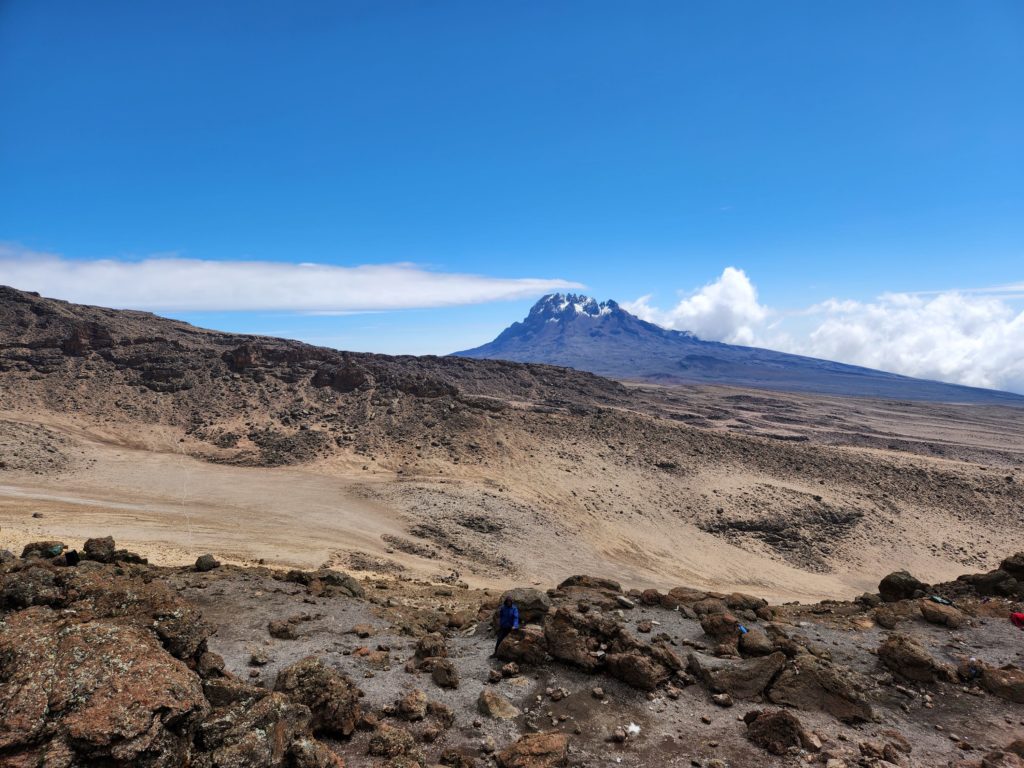
My Packing List (31 F)
Note that everything that was not rented on this list fit entirely inside of a 40L travel backpack + 28L daypack, along with my clothes for Zanzibar. No packing cubes used.
Clothing:
- 2x pairs exercise pants
- 2x pairs lined leggings
- 1x pair down pants
- 1x pair exercise shorts
- 6x exercise/hiking shirts
- 4x long sleeve shirts
- 1x fleece
- 1x down jacket
- 1x shell
- 2x long johns
- 9x pairs of underwear
- 2x sports bras
- 12x pairs of socks (extra for clean socks to sleep in at night)
- 1x rain jacket
- 1x pair of rain pants (rented from trekking company)
- 2x rain ponchos (only needed one)
- 1x warm hat
- 1x sun hat
- 1x ear warmers
- 1x liner gloves
- 1x ski gloves
- 1x balaclava
Equipment:
- 28L backpack
- Trekking poles (rented from trekking company)
- Four seasons sleeping bag and liner (rented from trekking company)
- Hiking shoes
- Change of shoes for camp
- Headlamp
- Knee brace
- Polarized sunglasses
- Baby wipes
- Pack of cards
- Journal & pen
- 2x portable chargers
- Sunscreen
- Bug spray
- Crampons (rented from trekking company)
- Leg gaiters (rented from trekking company)
- Go Pro camera
- Fitbit
- Menstrual products
- 2x 1.5L water bottles
- Moisturizer
Medication & snacks:
- Diamox (altitude sickness medication)
- Ibuprofen
- Antibiotics (emergency only)
- Cranberry supplements
- Emergen-C packets
- Nuum electrolytes
- Clif bars
- Clif blocs
- Dove milk chocolates
- Ginger chews
My Partners’ Packing List (31 M)
Because there’s overlap in the equipment and medication packing list, I will share just the clothes he brought. He also fit these into a 40L + 28L backpack.
- 2x pairs hiking pants (1 pair convertible to shorts)
- 1x pair lined sweatpants
- 1x pair down pants
- 3x hiking shirts
- 2x fleeces (1 thick, 1 light)
- 1x long johns
- 1x shell jacket
- 1x down jacket
- 1x rain jacket
- 1x rain pants
- 2x rain ponchos
- 1x pair leg gaiters (rented from trekking company)
- 1x balaclava
- 1x neck gaiter
- 1x beanie
- 1x sun hat
- 9x pairs underwear
- 10x pairs socks
- 1x liner gloves
- 1x ski gloves
Any questions about packing and preparing for Kilimanjaro? Feel free to ask.
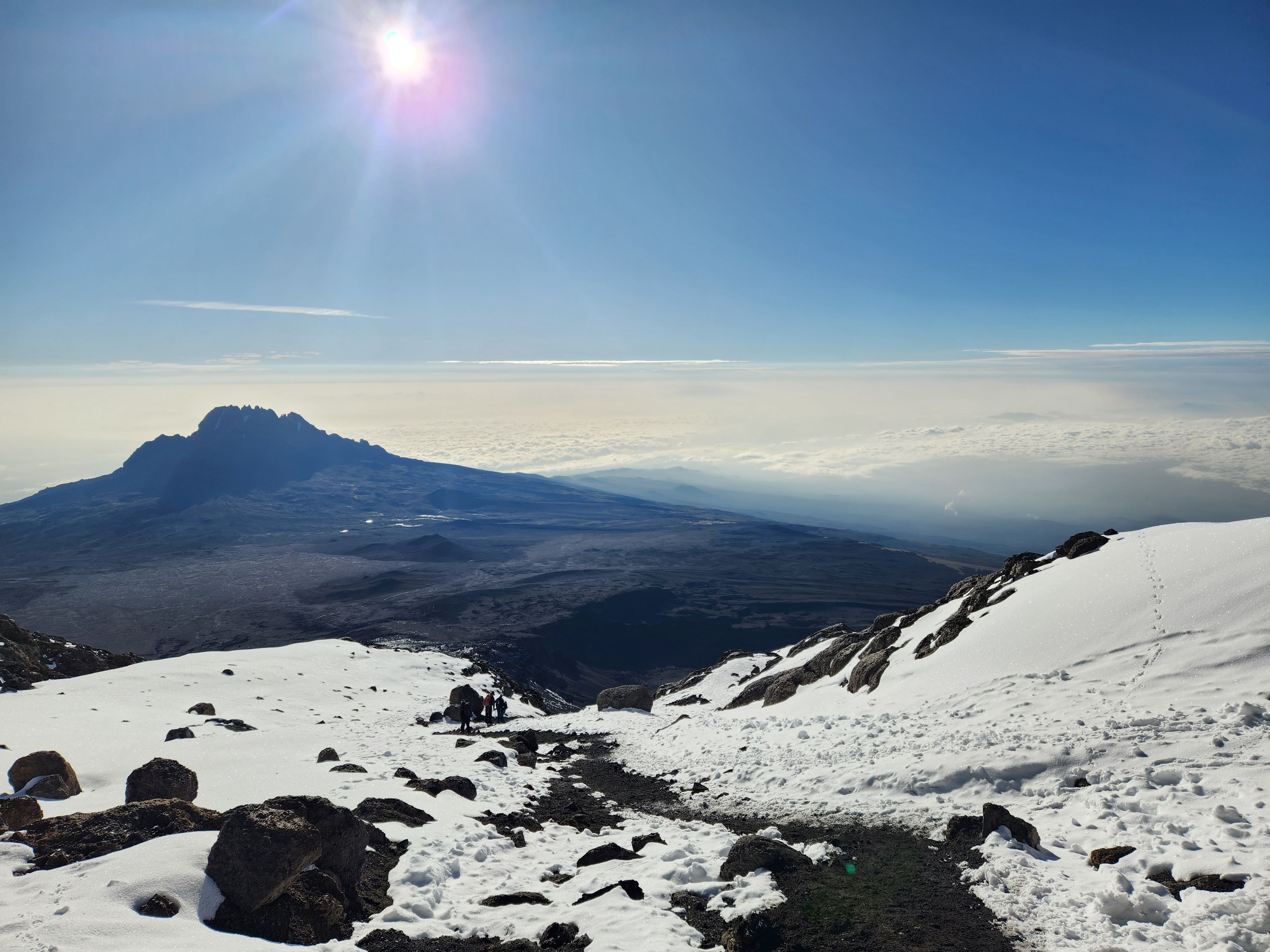

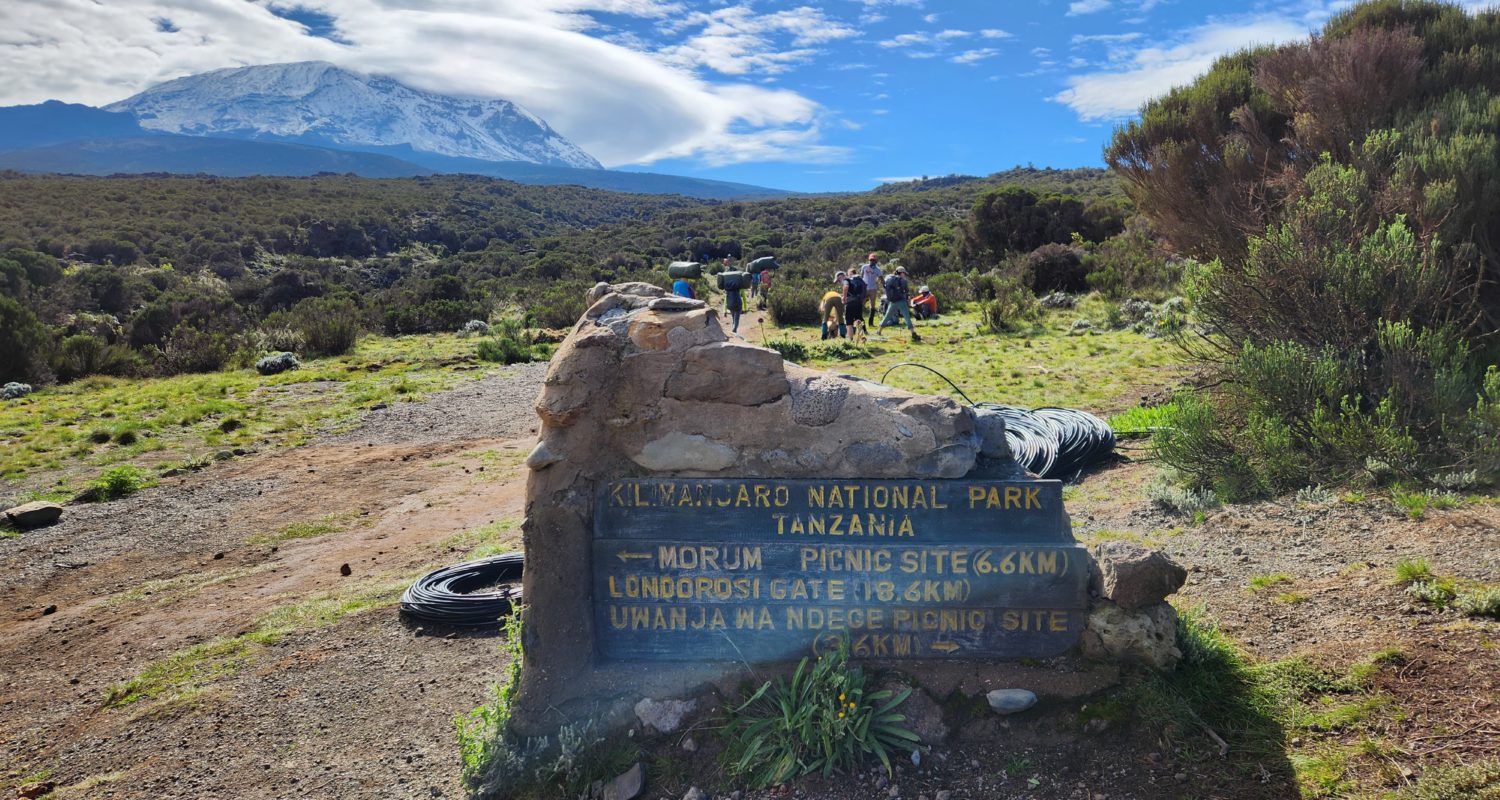
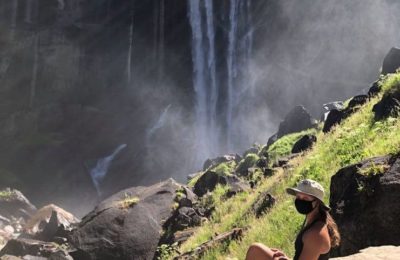
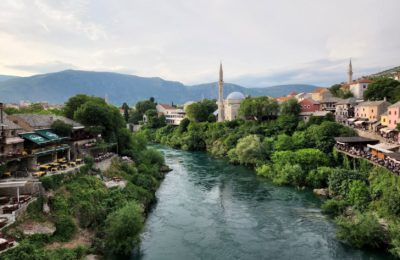
One thought on “Preparing for Kilimanjaro: How to Train and What to Pack for a Climb”